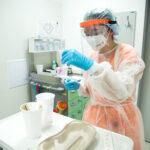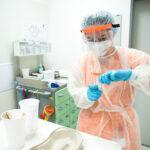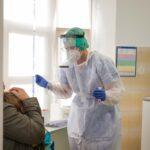Determining the sensitivity of the antigen test in a regimen that is close to the scenario of preventive testing was the aim of the study, which took place at the collection center FN Motol on 17 - 25 February 2021. It involved only people without symptoms covid-19 from the nasopharynx, ie. standard nasopharyngeal swab for PCR determination and at the same time nasal swab for antigen testing (Abbott test). The two results were then compared.
All study participants had the opportunity to repeat the antigen test (nasal swab) at two-day intervals as a self-collection so that the study took into account the aspect of repeating the antigen test. A total of 496 individuals participated in the study, and 360 of them provided information on the result of the self-test two days later.
The conclusions of the new study confirmed the previous results from autumn 2020, namely that the sensitivity of the antigen test is generally around 44% in asymptomatic individuals, but in the subgroup of "strongly positive" PCR it is about 75%. At that time, the test material was a nasopharyngeal swab, now a nasal swab. It can therefore be confirmed that for the purposes of antigen testing, a nasal swab is a sufficient and suitable alternative to a nasopharyngeal swab.
Repeated collection at short intervals clearly leads to an increase in the sensitivity of the antigen test (see tables below). Again, it was confirmed that the PCR test has a much higher sensitivity than antigen testing. "Thanks to the PCR method, it is possible to determine positivity, even if the antigen test still shows a negative result. Regular repetition of the antigen test is therefore a justified step, which is necessary to reduce the number of false negative cases, "says prof. MUDr. Pavel Dřevínek, Ph.D., Head of the Institute of Medical Microbiology, 2nd Medical Faculty, Charles University and University Hospital Motol. According to him, on the contrary, in this study, ie. using the already mentioned antigen tests, false positives were not detected on the day of collection at the Motol University Hospital. A positive antigen test has always meant a positive PCR test. Additional confirmation by the PCR method could therefore be dispensed with in practice. Unfortunately, this finding cannot be generalized to all tests on the market, as they may have lower specificity.
COURSE AND RESULTS OF THE STUDY (statistically processed in cooperation with doc. Michal Kulich from the Faculty of Mathematics and Physics, Charles University)
On the day of collection at FN Motol (Table No. 1), a total of 93 individuals were positive by PCR from nasopharyngeal swabs: in 54 of them the PCR signal was evaluated as “strongly positive”, in 39 as “weakly positive” (defined on the basis of PCR threshold values, so-called Ct). The antigen test on the day of PCR testing was positive in 41 individuals, all of whom belonged to the "strongly positive" PCR group. The sensitivity of the antigen test compared to PCR on the same day was 44%, but if it is determined only for a subset of "strongly positive" PCRs, then the sensitivity was close to 76%.
Table 1
| On the day of collection
and FN Motol |
number of cases | antigen test positive | antigen test negative | Sensitivity |
| PCR positive |
93 |
41 |
52 |
44,1% |
| PCR "strongly positive" (Ct <30) |
54 |
41 |
13 |
75,9% |
| PCR “weakly positive” (Ct> 30) |
39 |
0 |
39 |
|
| PCR negative |
403 |
0 |
403 |
Two days later (Table No. 2) the antigen test showed positivity in another 6 persons from the PCR group “strongly positive”, in addition it detected positivity in 5 persons from the PCR group “weakly positive” and in 2 persons who were PCR negative two days earlier. Thus, the antigen test reaches a sensitivity of up to 95% for a subset of PCRs "strongly positive" in the case of repeating the antigen test, which was performed two days later. At the same time, the antigen test begins to detect positive cases in the "weakly positive" PCR group.
Table 2
| number of cases | antigen on the day of collection in FNM | positive | positive | negative | negative | Sensitivity | |
| antigen two days later | positive | negative | positive | negative | |||
| PCR positive |
72 |
|
26 |
6 |
11 |
29 |
59,7% |
| PCR "strongly positive" |
40 |
26 |
6 |
6 |
2 |
95% |
|
| PCR "weakly positive" |
32 |
0 |
0 |
5 |
27 |
15,6% |
|
| PCR negative |
288 |
0 |
0 |
2 |
286 |
|
The table summarizes the results only from individuals for whom the result of the antigen test was available even two days later.
Press Release:
TZ_Anitgenic tests for surface testing (237,00 KB)


